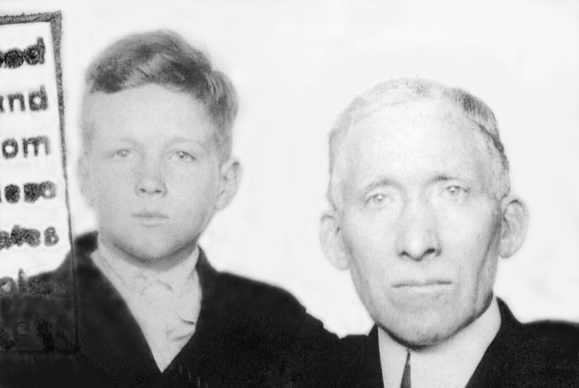This passport picture of Peter Dolan and his son Andrew was taken in 1924 and was used when Peter took his then eleven-year-old son from Chicago to Ireland to be raised in what must have been at the time a rare incidence of emigration from the USA to Ireland.
Dolan had been born in Croghan, Co. Roscommon in 1867. He emigrated to the USA around 1889 via Canada, moved to Chicago and married his wife, Martha, customarily late, at the age of 43 in 1910. He had three children, Edward, who was born in 1911 and who died at birth, Andrew who was born in 1912, and Charles, the youngest who was born in 1914. After the birth of her third son, Martha sadly went into post-partum melancholia and did not recover.
Unable to raise two energetic young boys by himself, Peter put them in Catholic boarding schools, but the mischief-loving Andrew got himself and Charles thrown out from more than one. The boys were separated and each was placed in the home of a maternal aunt. However, Andrew continued with his trouble-seeking ways, hopping freight trains from the age of nine and going missing for weeks at a time, before being returned by the police or railway security. After the third or fourth such adventure, the increasingly desperate Peter decided to send his young son to Ireland to be raised by his widowed sister, Brigid Kilfeather, who had three sons herself and who lived in Boyle, Co. Roscommon.
In order to preserve his pension, Peter Dolan had to return to the United States the very same day he dropped his son off. Two days later, Andrew disappeared. The Kilfeathers searched everywhere but despite combing the countryside couldn’t find him. Eventually, recalling his train-hopping exploits in America, they split up and followed the railway tracks. They found the enterprising youngster in a small town near the Sligo-Dublin railway tracks where he was earning food by telling the locals stories about America.
When asked what he thought he was doing, he cried, “I don’t want to hurt anyone’s feelings but I don’t like it here. So I am going home.” When told he couldn’t go home because it was very far away, he replied, “Oh yes, I can. There are tracks just like this running through my old neighborhood and I know that if I follow them long enough, they will take me home.”
The story quickly made the rounds and he became known in Boyle as the Little Yank. He stayed 10 years, ending up in school in Roscrea, Tipperary. He returned home a fine young man and became the faithful husband and attentive father his family remembers. His family recognize that they owe this to his Aunt B and the teachers and others in Ireland who helped “straighten him out,” just as his father had planned. ♦


Leave a Reply